10 Unmissable Sights in Petra, Jordan
“Petra: start your getaway here. Located in Jordan, this thousand-year-old city carved in sandstone is listed as a UNESCO World Heritage site. This impressive archaeological site covers an area of 264,000 square metres in the town of Wadi Musa. Book a few days to explore the vastness of this Jordanian tourist centre, full of breathtaking ancient monuments. This ancient treasure, which is over 2000 years old, is one of the Seven Wonders of the World. Among the must-see attractions are the “Siq”, the Treasury, the Royal Tombs, the theatre and two museums, all of which will give great insight into this mythical place. Follow our guide to reveal your inner Indiana Jones!
### 1/ The “Siq”.
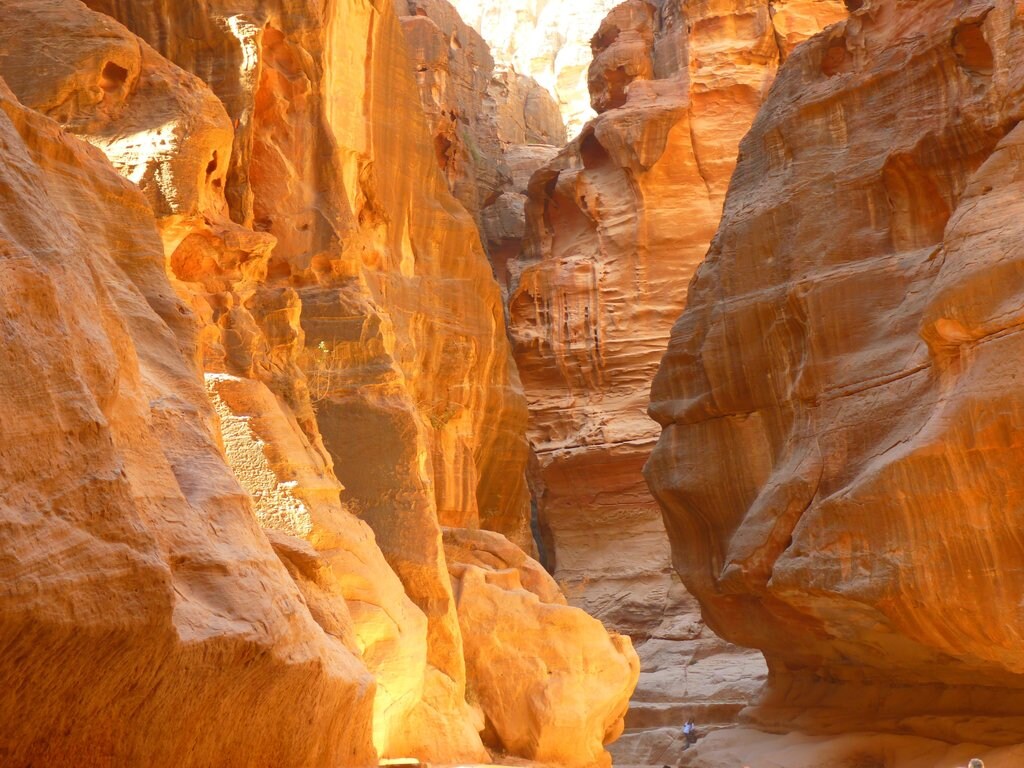
To enter this city located in the heart of the mountains, visitors will go through the “Siq”, a narrow, winding canyon that forms the entrance to the ancient city of Petra. On foot, on horse or on camel, the walk into the heart of this gorge, bordered by high cliffs, reveals its incredible beauty, where the shades of ochre, pink or red vary according to the daylight. After approximately 1200 metres, travellers can admire the Khazneh temple, also known as the “Treasury”.
### 2/ Khazneh / The Treasury
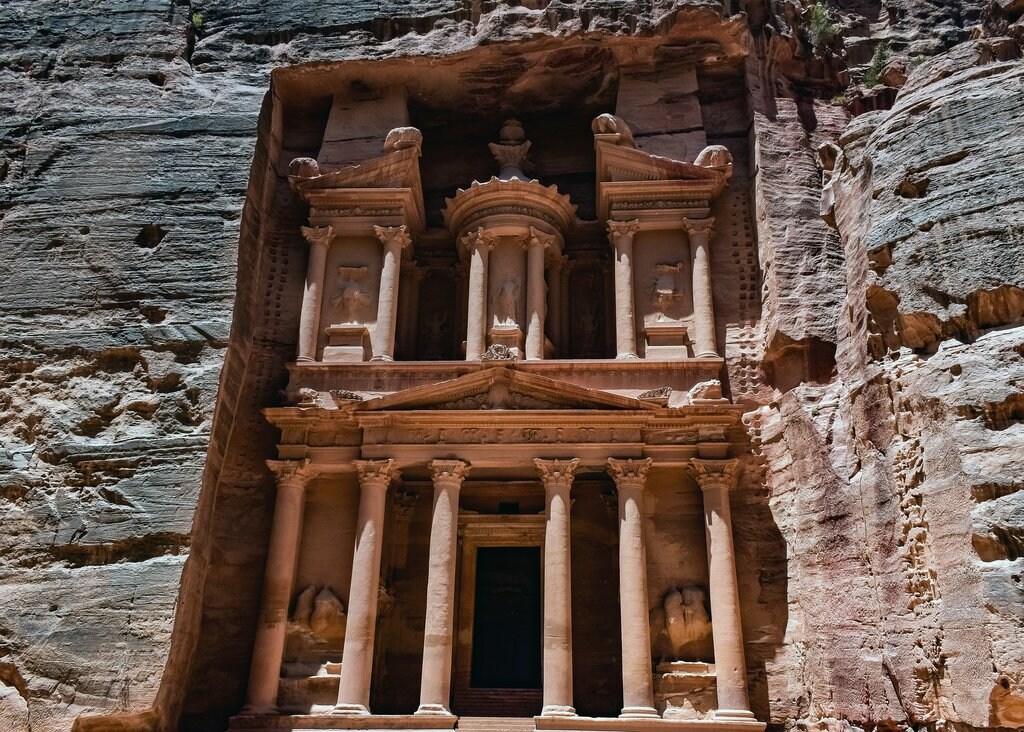 The indisputable symbol of Petra is undoubtedly the most famous monument of the ancient Nabataean city. The Nabataeans were an ancient Arab trading people, living in southern Jordan who established Petra as the capital of their kingdom. Housing a king’s tomb – probably that of King Aretas IV who died in 40AD – the Khazneh, which is nearly 40m high and 25m wide, is a temple with a façade decorated in Hellenistic style. The word “Khazneh” comes from Bedouin culture and means “Treasure of the Pharaoh”. Thus, legend has it that the urn concealed a treasure of great value. Bullet holes are a reminder of attempted looting.
The indisputable symbol of Petra is undoubtedly the most famous monument of the ancient Nabataean city. The Nabataeans were an ancient Arab trading people, living in southern Jordan who established Petra as the capital of their kingdom. Housing a king’s tomb – probably that of King Aretas IV who died in 40AD – the Khazneh, which is nearly 40m high and 25m wide, is a temple with a façade decorated in Hellenistic style. The word “Khazneh” comes from Bedouin culture and means “Treasure of the Pharaoh”. Thus, legend has it that the urn concealed a treasure of great value. Bullet holes are a reminder of attempted looting.
### 3/ The Nabataean theatre
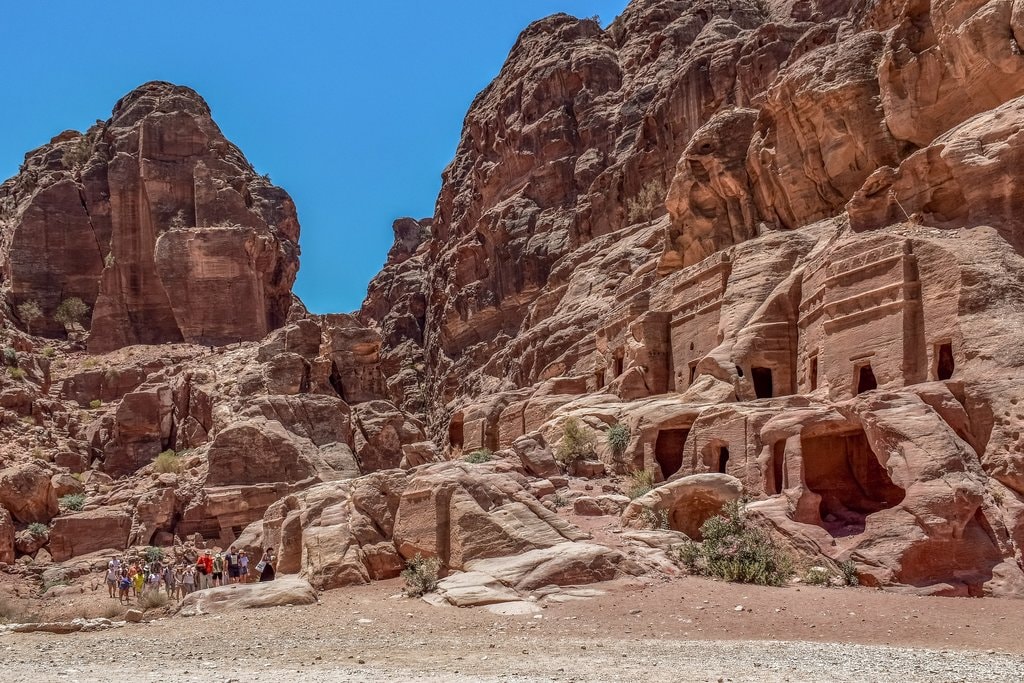
We continue our visit and head to the city, to see the Nabataean theatre which reputedly accommodated between 3,000 and 8,500 people. These remains, unearthed in the 1960s by a team of American archaeologists, date back to the 1st century AD. Although built in a Roman style, the construction was carried out during the Nabataean era and used a mixture of carved rock and stonework. It’s not hard to picture the ancient spectacles that took place in front of this majestic place!
### 4/ The Royal Tombs
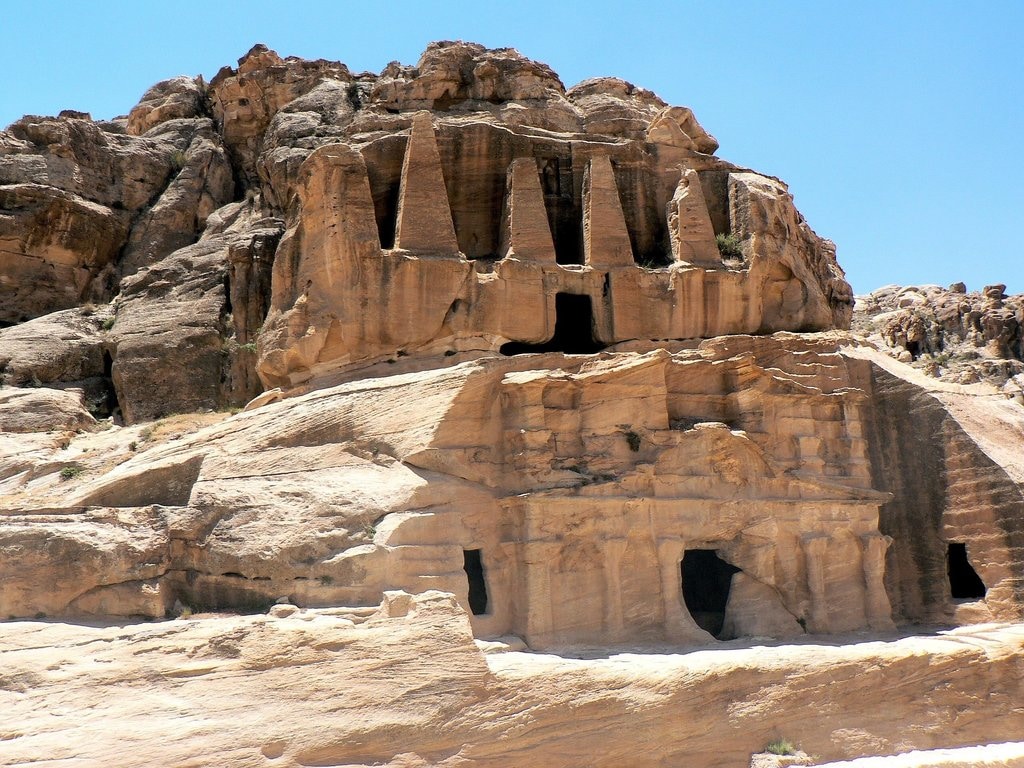
Unmissable trip in Petra: the ancient tombs. These were sculpted into the rock using very intricate patterns and never fail to pique travellers’ curiosity. The site contains about 3,000 rock art monuments, including more than 600 tombs carved in sandstone. Among these many tombs are five royal tombs built for Nabataean dignitaries, including the “Urn Tomb”, the “Corinthian Tomb” or the “Sextus Florentinus Tomb”.
### 5/ The Monastery
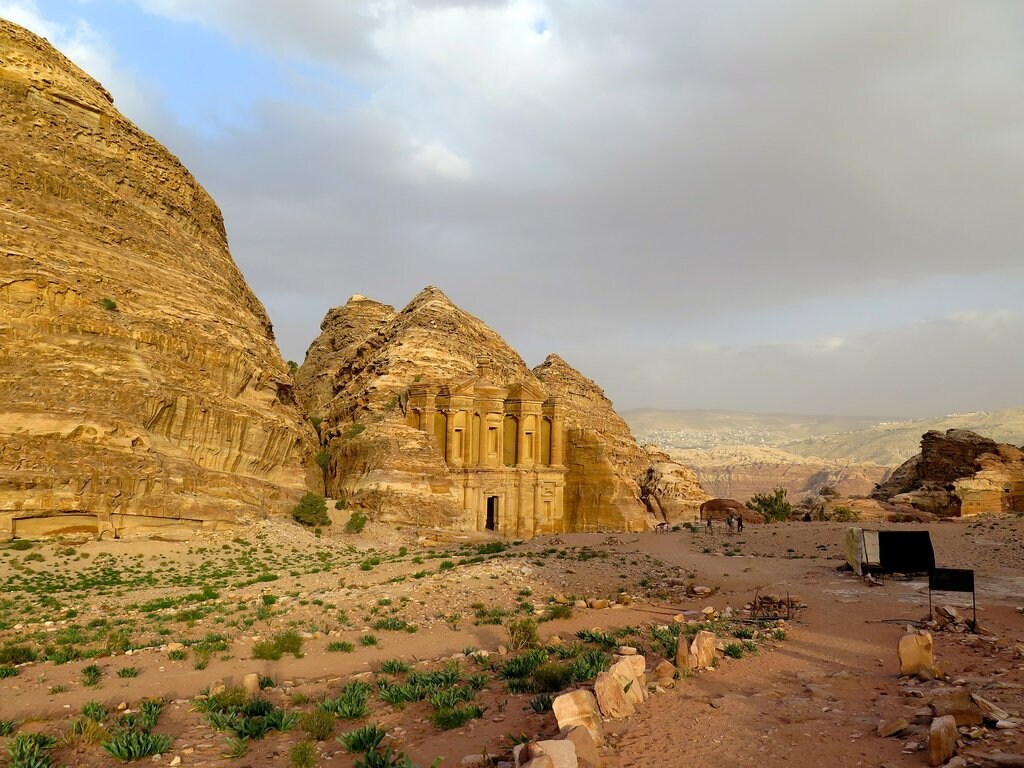
A feat for the brave: these magnificent remains can only be accessed via the 800 or so steps which have been carved into the cliff face. The Deir (from the Arabic al-Deir meaning “the monastery”) is one of the best known and largest buildings in the ancient city of Petra. The impressive building is 45m wide and 42m high. This monument was originally a tomb or place of worship and only became a monastery after the empire converted to Christianity in the 4th century AD.
### 6/ The museums of Petra
There are two museums in the ancient city. The Petra Archaeological Museum shows you the history of the site and its inhabitants, from the Edomite to Byzantine periods, with many ancient artefacts, tools and statues that were discovered during archaeological excavations. Those who would like to find out more can visit the Petra Nabataean Museum, which assembles artefacts discovered in the region, with a particular emphasis on the city’s former wealth and the Nabataean civilisation. If you are passionate about the history of this area, why not book a one-day private guided tour of Petra.
### 7/ The High Place of Sacrifice
Only for the most motivated, this is located at the top of a mountain. In the Nabataean era, this place of worship was dedicated to religious rituals and sacrifices in honour of the Gods. Of the two altars, one is dedicated to animal sacrifices, and the other to offerings. Once at the top of this magical and historic site, you can take in the breathtaking view of the Valley of Petra.
### 8/ Little Petra
Also listed as a UNESCO World Heritage Site, “Little Petra” is located only a few kilometres from the main site. After a well-earned break at your hotel in Petra, discover more of this site containing Nabataean ruins and a temple, architecturally reminiscent of the Khazneh. Another option: start your visit of the city at this site, as an “appetiser”. The visit ends with the chance to see “the most beautiful view in the world”!
### 9/ Beidha Neolithic village
Dating back to around 7,000 years BC, Beidha is a major Neolithic archaeological site located a few miles north of Petra, near Siq al-Barid and Little Petra. Beidha Neolithic village is said to be one of the oldest in the world. Here, you can see the ruins of houses and tombs.
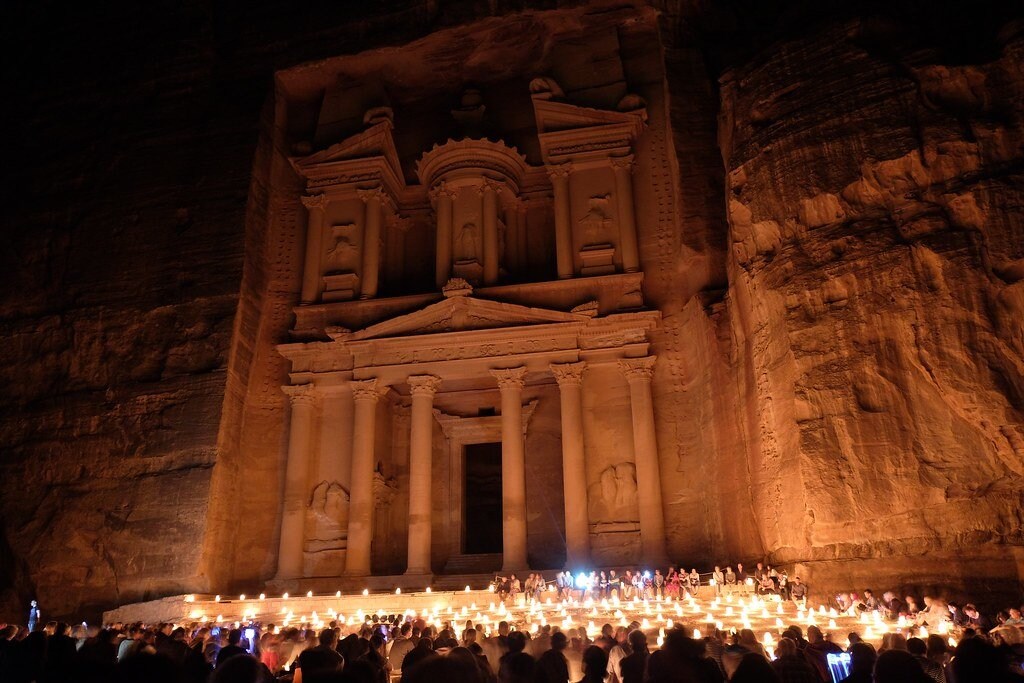
Petra by night. Photo credit: F H Mira under licence CC BY-SA 2.0
### 10/ “Petra by night”
Our final must-see sight is the ancient city of Petra at nightfall, lit by thousands of candles. This unique experience allows you to discover another side to the ancient city. After an almost mystical visit to the magnificent “Siq”, night-time visitors can immerse themselves in the atmosphere of ancient Petra in front of the “Treasury”. As a place of worship, a necropolis and a commercial city, curious travellers can discover the thousand different faces of Petra.
This city in the heart of the Jordanian desert is a veritable open-air museum, forgotten for many centuries by Westerners, and today bears witness to the richness of an ancient kingdom. However, its mysterious character remains as many remains are still to be excavated. The “pink” city of Petra has many secrets to discover!
Find a hotel near Petra for your perfect holiday!”
More Articles With History
Explore the UK’s fascinating history by visiting the ruins of its many castles. Here are 10 of the best abandoned castles in the UK.
Discover the very best museums and galleries through virtual tours. From London to New York, explore these online museums without leaving your home!
Curious to know why Bath earned itself a spot on UNESCO’s World Heritage list? Check out our guide to the Museum of Bath Architecture.
The beautiful country of Georgia makes for the perfect holiday. Here are the best things to do in Georgia, including mountains, monasteries, and more.
The beautiful country of Georgia is perfect for your next holiday. Here’s 10 reasons why you should visit Georgia!